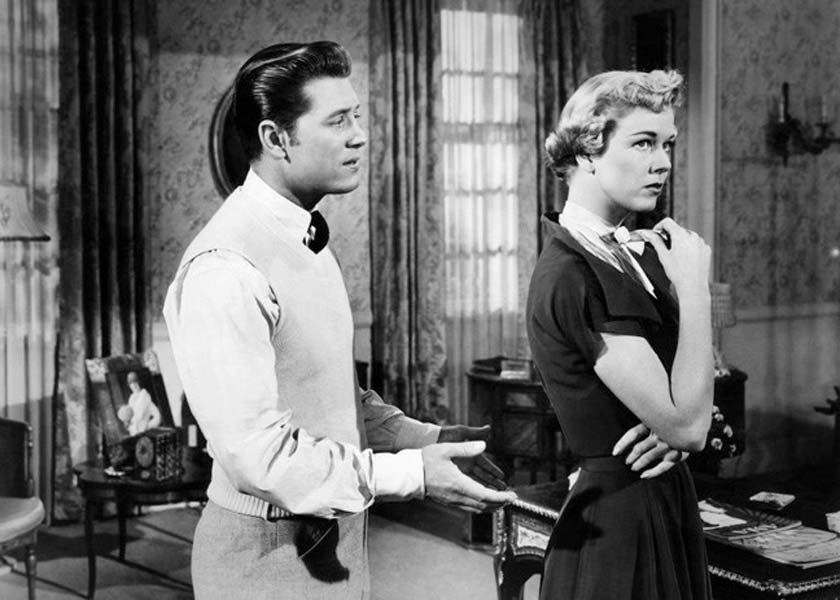Synopsis
J. Maxwell Max
Bloomhaus (S.Z. Sakall) tells his niece Nanette's (Day)
children her story. Flashing back to 1929, the stock market crash has wiped out
Nanette's fortune. Max, her financial manager, has not told her the bad news.
Jimmy Smith (MacRae) and Tommy Trainor (Nelson), who have written the words and
music for a show, are coaching the stage struck Nanette in singing and dancing.
Impresario Larry Blair (DeWolf) visits; he wants Nanette to finance Jimmy and
Tommy's musical. Blair offers Nanette the lead role. She agrees, although her
secretary Pauline Hastings (Arden) does not approve. Nanette asks Max for the
money. Max refuses. To avoid having to tell Nanette that she is broke, Max coaxes
her into a wager. If she can answer no
to all questions for 48 hours,
Nanette will win the bet and the money.
Max immediately tries to get Nanette to say yes
by asking her about the
music and the play, but no matter the question she replies no.
Her seeming
dislike of the project drives away the other backers. Nanette and Max even end up
in jail. A policeman stops Nanette for speeding, and she answers, no
to all
his questions. In a final attempt to get Nanette to say yes,
Max encourages
Jimmy to propose. When Nanette answers no
to his proposal, Jimmy leaves.
Nanette wins the bet, and Max is forced to tell her the truth. However, the show must go on, and Nanette and Pauline convince William Early (Bill Goodwin), the family lawyer, to put up the money. With Nanette the star, the show is a hit. Jimmy returns, and they renew their romance. Back in the present, Nanette and Jimmy arrive home and greet their children.
Discussion
Tea for Two is a bright, cheerful, and enjoyable vehicle for Doris
Day and Gordon MacRae, a delightful screen couple, with an amusing plot and plenty
of singing and dancing. The film contains eight songs. Four of them,
Tea For Two,
I Want to Be Happy,
No, No, Nanette,
and
Call of the Sea,
are the best songs from the 1925 musical
No, No Nanette, music by Vincent Youmans and lyrics by Irving Caesar
and Otto Harbach. (Caesar and Harbach also cowrote the operetta
The Desert Song, adapted to film in
1943 and
1953.) The 1950s arrangements, while
appropriate to Doris Day's style, do not fit the 1920s flavor of these songs.
The play and the film share the title, the songs, and the names of the leading
lady and some of the other characters. However, the plots and the personalities of
the characters are unalike. In the play, Nanette is a young woman who wants to
kick up her heels and see something of life before she settles down to marry her
boyfriend, Tommy. The No, no
in the title refers to the objections of the
other characters to Nanette going, with only the cook, Pauline, as a chaperone, to
cavort (harmlessly) at the beach in Atlantic City.
Day and MacRae paired pleasantly in four films. Tea For Two was followed by The West Point Story (1950), a vehicle for James Cagney in which Day and MacRae are supporting players. On Moonlight Bay (1951) and By the Light of the Silvery Moon (1953) are enjoyable and nostalgia-filled romantic comedies with period music.
By the mid-1950s, film musicals were in decline. Doris Day successfully continued her career with romantic comedies, including Teacher's Pet (1958), Pillow Talk (1960) and That Touch of Mink (1962), interspersed with dramas, including The Man Who Know too Much (1956) and Midnight Lace (1960). After starring in the filmed versions of two acclaimed Broadway musicals, Oklahoma (1955) and Carousel (1956), Gordon MacRae’s film career waned. He continued his musical career in alternate venues: television, national tours with musical comedies, summer stock and nightclubs.
S. Z Sakall, born in Hungary, appeared in more than fifty Hungarian and German
films between 1916 and 1937. When Hungary joined the Axis in 1940, Sakall (who was
of Jewish descent) and his wife moved to the United States. Exploiting his chubby
cuteness, high-pitched, accented voice, and fractured English, Sakall specialized
in affectionate, well-meaning and bumbling older men, usually fathers, uncles and
employers. He appeared in 41 American films from 1940 to 1954, mostly for Warner
Bros. The nature of his appeal to the American movie-going public is shown in the
studio's nickname for him — Cuddles
— that was often included
in cast lists.
By 1933, director David Butler had been active in films for twenty years and would continue for the next thirty. Butler began his career as an actor; he signed with D.W. Griffith in 1915 and had uncredited roles in The Birth of a Nation (1915) and Intolerance (1916). As an actor, Butler appeared in over fifty silent films, occasionally as star, but mostly as a supporting player. His most notable roles are substantial parts in The Sky Pilot (1921), directed by King Vidor, and 7th Heaven (1927), directed by Frank Borzage. As silent films ended, Butler switched over to directing. Almost immediately, he had a hit with Sunnyside Up, a musical comedy starring Janet Gaynor and Charles Farrell and one of the most popular films of 1929. He specialized in comedies, with or without music, many with major stars of the 1930s, 1940s, and 1950s including Will Rogers, Bob Hope, Bing Crosby, and Doris Day. In 1955, as musicals were declining in popularity, Butler turned to television. From 1955 until his retirement in 1967 he directed episodes of many television series, including 58 episodes of Leave It To Beaver (1959-63). Although Butler was a competent director and made some interesting films, robust comedy was more his forte than the delicate charm reqiured of My Weakness, and he may have been unable to bring out the best of Harvey’s own unique mixture of charm and delicacy.

